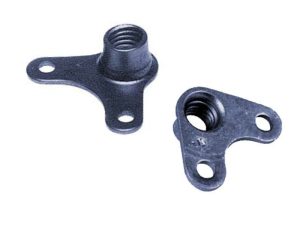
Nuts and bolts are two of the world’s most popular types of fasteners. Nuts feature internal threads, whereas bolts feature external threads. To secure two or more objects, you can insert a bolt through the objects, followed by twisting a nut onto the end of the bolt. In addition to standard nuts, however, there are nutplates. Here are five facts about nutplates.
#1) Riveted in Place
Nutplates are typically riveted in place. As shown in the photo above, they feature internal threads in the center, along with two small holes off to the sides. The internal threads allow nutplates to support a threaded fastener, such as a bolt. The small holes, on the other hand, are used to mount nutplates, which is typically done with rivets.
#2) Originally Designed for the Aerospace Industry
While they are now used in a myriad of fastening applications, nutplates were originally designed for the aerospace industry. Aircraft structures are often riveted, which makes it difficult to access the back of parts. With nutplates, engineers can install bolts or similar threaded fasteners without accessing the back of parts, making them ideal for aerospace-related applications.
#3) Available in Fixed and Floating Styles
You can find nutplates in fixed and floating styles. Fixed nutplates are completely stationary, whereas floating nutplates feature internal threads that move slightly. What’s the purpose of floating nutplates exactly? With a moving nut in the center, they enlarge the positioning tolerances of the objects with which they are used. Even if a bolt isn’t perfectly aligned in front of a floating nutplate, it may still fit. The moving nut can shift so that it catches the bolt and allows for a secure connection.
#4) Available in Capped and Open Styles
In addition to fixed and floating, nutplates are available in capped and open styles. Capped nutplates feature a closed nut in the center that’s capped on the bottom, whereas open nutplates feature an open nut. They are used in many of the same applications. The difference is that open nutplates allow for longer fasteners. You can twist a fastener through an open nutplate. Closed nutplates, in comparison, must be used with fasteners of specific lengths. If a fastener is too long, closed nutplates may not support it.
#5) Reusable
Nutplates are reusable. Whether fixed or floating, capped or open, you can reuse them. While nutplates themselves are typically reusable, though, rivets may not be. Most rivets are designed for one-time use. When you install a rivet, you’ll need to deform it. Therefore, if you reuse a nutplate, you should install it with a set of new rivets.



